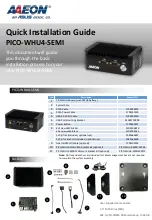
OLIMEX© 2018
A20-OLinuXino-MICRO user's manual
2.4 Prebuilt software
The boards comes with no software uploaded. The board versions with extra flash memory also
come blank. Typically, the boards with NAND flash memory have the boot regions fixed, allowing
easier Linux install (eMMC boards don't need such preparation).
You can download the latest Linux Debian or Android image from the wiki article of the board and
download it to a microSD card. You can also install the Linux to the flash memory via install script.
If your board has extra flash memory and you want to boot Android from it refer chapter
6.1.1
USB-OTG communication (NAND firmware repair/update).
The default super user and password combination for the official Linux images is: “root” –
”olimex” and the GUI runs under user “olimex” with password “olimex”.
2.5 Button functions
The bellow three buttons usually are supported under both Android and Debian:
PWR_BUT
– used to perform software turn off, software turn on; used to turn on board when
powered by battery – has to be held down for at least couple of seconds to perform each action;
RESET
– used for hardware reset of the board – it is not recommended to reset the board this way;
RECOVERY
– used to wake up the board from sleep
The following buttons represent functions in the Android (it is possible that not all Android
applications take advantage of the buttons, in such case the button would serve no purpose for that
application):
VOL+
– increases the volume
VOL-
– lowers the volume
MENU
– brings up the main menu
SEARCH
– brings up search feature
HOME
– shows the home screen; note that HOME is also used to enter bootloader mode for
firmware update
ESC
– used to navigate away of a menu
ENTER
– to select a choice
It is not recommended to disconnect the power supply (either the USB or the power jack) before
turning off the Android from the either the menus or by holding PWR_BUT. This might lead to file
system corruption and would require re-writing the image on the flash memory.
How to restore the Android image might be found in chapter “6.1.1 USB-OTG communication
(NAND firmware repair/update)”.
Page 11 of 56
































